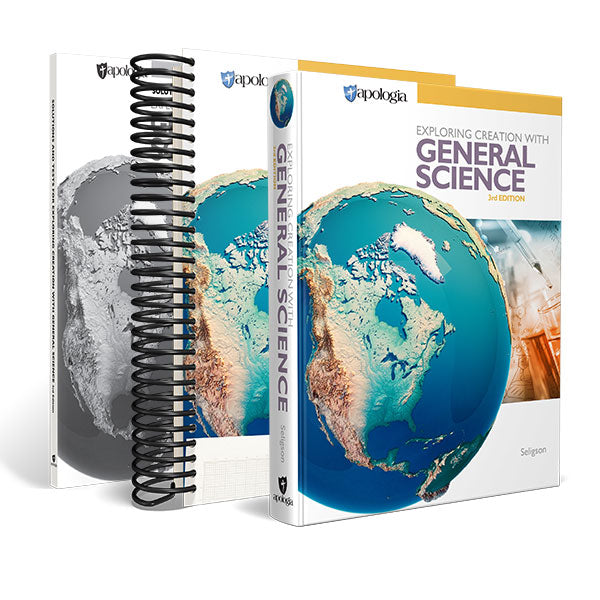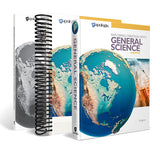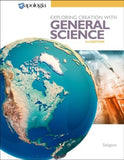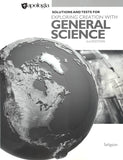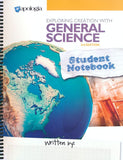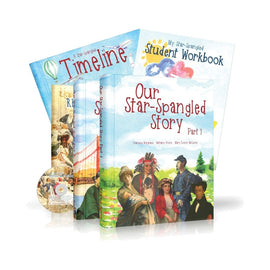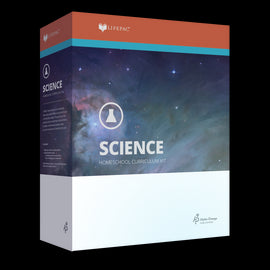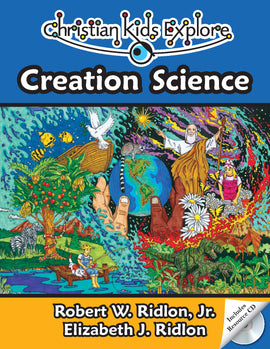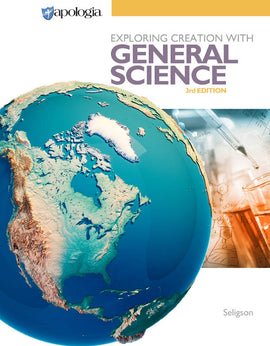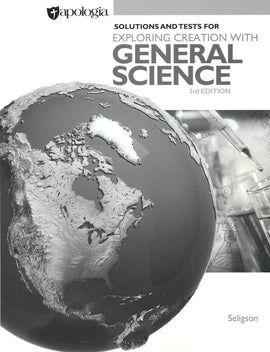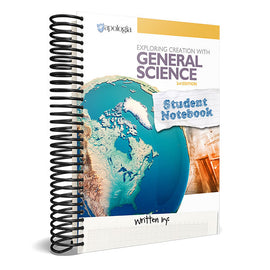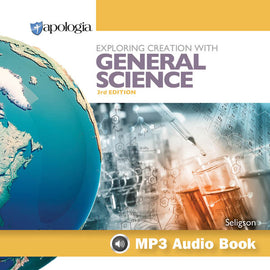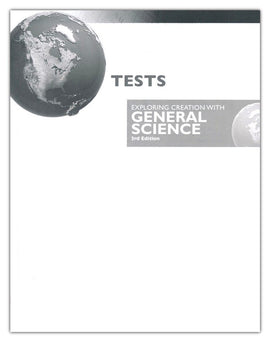Apologia Exploring Creation with General Science Basic Set, 3rd Edition
Exploring Creation with General Science, 3rd Edition, is part of Apologia’s award-winning homeschool science curriculum for middle school students. This course is designed to help middle school students transition in their homeschool work from the elementary level to seventh grade.
Special Notes:
- Recommended level: 7th grade
- This Apologia Basic Set includes the student textbook, Solutions and Test Manual, and the spiral-bound Student Notebook.
Textbook
This is a true general science course covering a wide range of the branches of science. There is a large component of Earth Science (modules include astronomy, meteorology, oceanography, earth study, geology, paleontology, and environmental science) to give students a great foundation of that broad field of study.
Exploring Creation with General Science, 3rd Edition, has been rewritten to truly walk each student through middle school’s transition time from the elementary years to the high school sciences. Specifically designed to be the first course taken during junior high, it was created to give middle school students an understanding of the basic world that surrounds them each day of their lives so that they can appreciate the real-world relevance of scientific inquiry and the beauty of creation.
The students will learn what science is and, in a detailed and engaging way, how to utilize the proper scientific method.
Students are walked through how to record data and report it. Too often, students are not given instruction in how to read and create graphs (a skill that is found on SAT and ACT exams!), however, they are taken through the process of creating several graph types, learning how to properly design and read them, too.
The final module is a fun and exciting culmination of the course. It has no exam, rather students are given step-by-step instructions to build a final project of creating a Rube-Goldberg machine, incorporating many of the scientific principles they learned throughout the year (such as combustion, buoyancy, simple machines, and more). Between the project set-up instructions, students will read testimonies from modern-day scientists, sharing how they see God’s hand as they work in their respective fields of science.
Lesson Plans and Materials: The course is designed to be done 4 days a week (as compared to 2 days a week for our elementary series and 5 days a week for our high school courses). The book is written in a conversational format as the author talks directly to students, walking them through how to complete experiments, how to identify the important parts of the information presented, and where and how to take notes as they progress. The student notebook pairs perfectly with this process, providing easy-to-understand graphics where students fill in the blank spaces as they read. Thus, they are learning how to take information out of a text, identify key points, and critically think through what they are learning. Daily lesson plans are included in the student notebook so students easily understand what is expected of them each day, yet there is still room for flexibility in the schedule to meet the needs of the student and the family.
Experiments: In early modules, specific portions of the text are highlighted so students know where to find important information for lab write-ups, and they are guided through that process. Although the students might complete more than one experiment in a module, they are given the opportunity to choose a single experiment on which they want to complete a lab report, thus providing the opportunity to build on interest-driven learning. Lab report samples are provided so the students learn proper formatting and what is expected of them. All of the experiments in this course utilize easy-to-obtain household materials, so no special equipment is necessary, yet complex scientific principles are easy to explore and understand.
Bonus Hands-on Work: Middle school-aged children still greatly benefit from hands-on exploration, so like our elementary series, we include several optional activities (called Explore More) to allow students to further explore the scientific concepts presented in each module.
Tests: There are tests provided for each module, however, students are given many study helps via their student notes within the Student Notebook, and a practice Study Guide they complete once they complete a module. The first two module tests are assigned to be given as open-book tests so that students learn the format of this course and more easily transition to improve the skill of test-taking, thus preparing them for upper grades and even college work.
Character-building: Middle school-aged students are in a transition period between childhood and adulthood, and we believe it is important to emphasize the importance of character. Thus in each module, parents are encouraged (and guided) to incorporate character performance into their student’s grade.
Grading: Complete, step-by-step grading rubrics are provided to the parents, showing how to calculate a module grade from the student’s module test, lab work, and character displayed throughout the module.
Seeing God’s Creative Hand: Throughout the course, students are able to see evidence of God’s creation as they learn scientific principles. Additionally, they will be excited to learn about many great scientists in history who were driven to study our world out of a desire to better know God as its creator. The course is sandwiched by this historical information within the first module and a presentation of testimonies by modern-day scientists in the last module to help encourage students to study science to better know God and give him glory!
Student Notebook
Note-taking is a learned skill. While it might seem like there should be “answers” to questions and prompts found in the student notebook, we do not provide specific answers on purpose. The best way to take notes is the way that works for the student. That’s why the Student Notebook introduces the student to several methods for taking notes. At the beginning of each module in their Student Notebooks, students are encouraged to take mindful notes using techniques that expand as the school year progresses.
The Student Notebook also includes tips for writing good notes. Here are just some tips for writing good notes that students will be introduced to in this notebook:
- Make sure to include the main ideas of each passage and list the minor concepts under the main ones.
- Use the author’s style to guide your notes. If the author defines a term, make sure you include that definition in your notebook (you won’t miss it; we have it there ready for you to define).
- If the author is comparing or contrasting two things in the text, you should compare and/or contrast in your notes (again, we’ll provide you with some diagrams to help you do this).
- If the author is classifying in the text, you should classify in your notes (and remember to include any hints you think of).
- Don’t copy the text word for word. Always write your notes in your own words and make as many connections to ideas you already know as you can.
- If you see a word you don’t know, write it down and look it up so you can better understand what you’re reading.
The section in the Student Notebook where notes are recorded was created to give students prompts or questions to lead them to the important information they will read in the text. Answering these prompts will help them take effective notes. The notes a student takes are personal to them and their answers may be different from another student’s answers, but they can be sure to find the information on the pages they’re instructed to read.
Although there is no one right way to take good notes, after trying the techniques in this notebook students should find the way that works best for them. Then they’ll have a much better handle on all the interesting and sometimes amazing things they will learn in general science this year.
Additionally, we purposely designed this course so that the first 2 exams are open book – meaning that students can use their textbook and notebooks when answering questions. We encourage them to evaluate their note-taking efforts after each exam. Were their notes helpful in the exam? If yes, they are capturing important information. If no, they need to learn to pull more information out of the textbook. Don’t worry, we help them there too. Using colored text and prompts to steer them in the right direction, we essentially walk your student through the note-taking experience.
Apologia encourages parents to review their student’s notebook to make sure that the student is properly engaged, however, student notes should never be graded. You can choose to use the character-building points in your evaluations. Offer encouragement if you see your student struggling. Ask them to review with you what they are learning. Mentor to them how you took notes at their age. You will see that with each notebook module we offer tips and hints. By the time your student finishes the course, you’ll see highlighting and colored fonts, personal thoughts expanded and explored, and a true knowledge on how to personalize, capture, and understand new knowledge.
The General Science Student Notebook Includes:
- Daily Lesson Plan
- Breakdown of the assignments, detailing exactly what needs to be done each day
- Pages where the student takes notes. These pages include prompts to help teach the student how to pull out pertinent information from the text.
- Space to answer the On Your Own questions that are listed in each module.
- Space to record their results from the many hands-on activities.
- Solutions and Test Manual only for Exploring Creation with General Science, which contains answers to Study Guide questions, module summaries, tests, and test solutions. One test packet is included with this manual.
- Creation Connection pages where students record their intellectual, emotional, and spiritual reactions to what they are learning.
- Space to record answer to the On Your Own questions. These questions serve as review and prep for the tests.
Copyright 2019
| Book Title | Apologia Exploring Creation with General Science Basic Set, 3rd Edition |
| Publisher: | Apologia Educ. Ministries |
Exploring Creation with General Science, 3rd Edition, is part of Apologia’s award-winning homeschool science curriculum for middle school students. This course is designed to help middle school students transition in their homeschool work from the elementary level to seventh grade.
Special Notes:
- Recommended level: 7th grade
- This Apologia Basic Set includes the student textbook, Solutions and Test Manual, and the spiral-bound Student Notebook.
Textbook
This is a true general science course covering a wide range of the branches of science. There is a large component of Earth Science (modules include astronomy, meteorology, oceanography, earth study, geology, paleontology, and environmental science) to give students a great foundation of that broad field of study.
Exploring Creation with General Science, 3rd Edition, has been rewritten to truly walk each student through middle school’s transition time from the elementary years to the high school sciences. Specifically designed to be the first course taken during junior high, it was created to give middle school students an understanding of the basic world that surrounds them each day of their lives so that they can appreciate the real-world relevance of scientific inquiry and the beauty of creation.
The students will learn what science is and, in a detailed and engaging way, how to utilize the proper scientific method.
Students are walked through how to record data and report it. Too often, students are not given instruction in how to read and create graphs (a skill that is found on SAT and ACT exams!), however, they are taken through the process of creating several graph types, learning how to properly design and read them, too.
The final module is a fun and exciting culmination of the course. It has no exam, rather students are given step-by-step instructions to build a final project of creating a Rube-Goldberg machine, incorporating many of the scientific principles they learned throughout the year (such as combustion, buoyancy, simple machines, and more). Between the project set-up instructions, students will read testimonies from modern-day scientists, sharing how they see God’s hand as they work in their respective fields of science.
Lesson Plans and Materials: The course is designed to be done 4 days a week (as compared to 2 days a week for our elementary series and 5 days a week for our high school courses). The book is written in a conversational format as the author talks directly to students, walking them through how to complete experiments, how to identify the important parts of the information presented, and where and how to take notes as they progress. The student notebook pairs perfectly with this process, providing easy-to-understand graphics where students fill in the blank spaces as they read. Thus, they are learning how to take information out of a text, identify key points, and critically think through what they are learning. Daily lesson plans are included in the student notebook so students easily understand what is expected of them each day, yet there is still room for flexibility in the schedule to meet the needs of the student and the family.
Experiments: In early modules, specific portions of the text are highlighted so students know where to find important information for lab write-ups, and they are guided through that process. Although the students might complete more than one experiment in a module, they are given the opportunity to choose a single experiment on which they want to complete a lab report, thus providing the opportunity to build on interest-driven learning. Lab report samples are provided so the students learn proper formatting and what is expected of them. All of the experiments in this course utilize easy-to-obtain household materials, so no special equipment is necessary, yet complex scientific principles are easy to explore and understand.
Bonus Hands-on Work: Middle school-aged children still greatly benefit from hands-on exploration, so like our elementary series, we include several optional activities (called Explore More) to allow students to further explore the scientific concepts presented in each module.
Tests: There are tests provided for each module, however, students are given many study helps via their student notes within the Student Notebook, and a practice Study Guide they complete once they complete a module. The first two module tests are assigned to be given as open-book tests so that students learn the format of this course and more easily transition to improve the skill of test-taking, thus preparing them for upper grades and even college work.
Character-building: Middle school-aged students are in a transition period between childhood and adulthood, and we believe it is important to emphasize the importance of character. Thus in each module, parents are encouraged (and guided) to incorporate character performance into their student’s grade.
Grading: Complete, step-by-step grading rubrics are provided to the parents, showing how to calculate a module grade from the student’s module test, lab work, and character displayed throughout the module.
Seeing God’s Creative Hand: Throughout the course, students are able to see evidence of God’s creation as they learn scientific principles. Additionally, they will be excited to learn about many great scientists in history who were driven to study our world out of a desire to better know God as its creator. The course is sandwiched by this historical information within the first module and a presentation of testimonies by modern-day scientists in the last module to help encourage students to study science to better know God and give him glory!
Student Notebook
Note-taking is a learned skill. While it might seem like there should be “answers” to questions and prompts found in the student notebook, we do not provide specific answers on purpose. The best way to take notes is the way that works for the student. That’s why the Student Notebook introduces the student to several methods for taking notes. At the beginning of each module in their Student Notebooks, students are encouraged to take mindful notes using techniques that expand as the school year progresses.
The Student Notebook also includes tips for writing good notes. Here are just some tips for writing good notes that students will be introduced to in this notebook:
- Make sure to include the main ideas of each passage and list the minor concepts under the main ones.
- Use the author’s style to guide your notes. If the author defines a term, make sure you include that definition in your notebook (you won’t miss it; we have it there ready for you to define).
- If the author is comparing or contrasting two things in the text, you should compare and/or contrast in your notes (again, we’ll provide you with some diagrams to help you do this).
- If the author is classifying in the text, you should classify in your notes (and remember to include any hints you think of).
- Don’t copy the text word for word. Always write your notes in your own words and make as many connections to ideas you already know as you can.
- If you see a word you don’t know, write it down and look it up so you can better understand what you’re reading.
The section in the Student Notebook where notes are recorded was created to give students prompts or questions to lead them to the important information they will read in the text. Answering these prompts will help them take effective notes. The notes a student takes are personal to them and their answers may be different from another student’s answers, but they can be sure to find the information on the pages they’re instructed to read.
Although there is no one right way to take good notes, after trying the techniques in this notebook students should find the way that works best for them. Then they’ll have a much better handle on all the interesting and sometimes amazing things they will learn in general science this year.
Additionally, we purposely designed this course so that the first 2 exams are open book – meaning that students can use their textbook and notebooks when answering questions. We encourage them to evaluate their note-taking efforts after each exam. Were their notes helpful in the exam? If yes, they are capturing important information. If no, they need to learn to pull more information out of the textbook. Don’t worry, we help them there too. Using colored text and prompts to steer them in the right direction, we essentially walk your student through the note-taking experience.
Apologia encourages parents to review their student’s notebook to make sure that the student is properly engaged, however, student notes should never be graded. You can choose to use the character-building points in your evaluations. Offer encouragement if you see your student struggling. Ask them to review with you what they are learning. Mentor to them how you took notes at their age. You will see that with each notebook module we offer tips and hints. By the time your student finishes the course, you’ll see highlighting and colored fonts, personal thoughts expanded and explored, and a true knowledge on how to personalize, capture, and understand new knowledge.
The General Science Student Notebook Includes:
- Daily Lesson Plan
- Breakdown of the assignments, detailing exactly what needs to be done each day
- Pages where the student takes notes. These pages include prompts to help teach the student how to pull out pertinent information from the text.
- Space to answer the On Your Own questions that are listed in each module.
- Space to record their results from the many hands-on activities.
- Solutions and Test Manual only for Exploring Creation with General Science, which contains answers to Study Guide questions, module summaries, tests, and test solutions. One test packet is included with this manual.
- Creation Connection pages where students record their intellectual, emotional, and spiritual reactions to what they are learning.
- Space to record answer to the On Your Own questions. These questions serve as review and prep for the tests.

